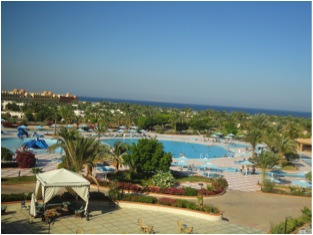Colliers International expects tourism to Sharm El-Sheikh and Hurghada to decline, while tourism to Cairo and Alexandria is projected to increase.
In a report evaluating the performance of the four major cities in the Egyptian tourism sector over the last year, of which Daily News Egypt obtained a copy, Arab tourism to Cairo and Alexandria was expected to surge.
Meanwhile in the wake of travel restrictions to Sinai, businesses in Sharm El-Sheikh and Hurghada have a greater reliance on domestic tourism, according to the report.
Hotel capacity has increased dramatically in Cairo following the opening of the Nile Ritz Carlton Hotel and the Kempinski Hotel Maxim, with 245 and 331 rooms respectively.
The Tulip Hotel on Haram Street also added 410 rooms, boosting the capacity of brand-name hotels in Cairo to 15,157 rooms, marking a 7% growth rate from the previous year.
The report said west and east Cairo are benefiting from the demand, which was previously limited to hotels in downtown Cairo, due to security concerns and the latter’s proximity to Tahrir Square. However, over the past year hotels in downtown Cairo achieved 28% growth since 2014, the highest growth in occupancy rates in all of Egypt.
Colliers said the increase reflects consumers’ confidence in the market.
The market, according to Colliers, still maintains development opportunities in five-star hotels, as well as longer-term apartment hotels only available in Cairo, which enables international operators to penetrate the market.
In Sharm El-Sheikh, in which more than 75% of the five-star brand-name hotels are located, demand has remained steady, indicating that foreign and domestic tourists seek high quality services and products.
Sharm El-Sheikh has seen some market volatility over the past few years. A Russian Metrojet airliner crashed in Sinai last October, killing all 224 crew and passengers aboard. This led to a major decline in occupancy in 2015 due to this incident and other events occurring in Sinai, which prompted certain governments to issue travel warnings to their nationals.
Secondary hotels that used to attract excess demand in peak times have been suffering lately, according to Colliers, noting that associating these weaker hotels with brand-names would be advantageous.
Hotel performance has been experiencing a decline in 2016.
Hotels postponed or cancelled their deals as a result of low demand, according to Colliers. However, local tourists continue to request deals in Sharm El-Sheikh, specifically families and large groups.
Increase in hotel capacity in Hurghada has been steady over the past year, especially across five, four, and three star hotels, which each represent about 33% of the total capacity.
The Hilton will expand by 1,000 rooms in two of its hotels in 2017.
Hurghada and Sharm El-Sheikh have both been affected by travel warnings issued by EU countries, though Hurghada is still a popular destination for Egyptians. Despite the decline in occupancy in 2015, the length of stays extended by 13%.
Colliers expects the travel bans to continue throughout the first few months of 2016, meaning the European tourism will continue to decline, but domestic tourism will grow.
“This decline will push tour operators and hotels to promote Egyptian tourism in Gulf Cooperation Council (GCC) countries,” Colliers stated.
The report noted that hotel capacity in Alexandria increased by 4% during the last year, signalling plans to increase capacity during in 2016.
Occupancy in Alexandria rose by 11%, while the average length of stay rose by 3%. Inland hotels are aiming to offer better performance so as to have the advantage over beachfront hotels.
Fly Dubai increased the number of flights to Alexandria late last year, which will encourage tourists from the Gulf to visit Alexandria.




